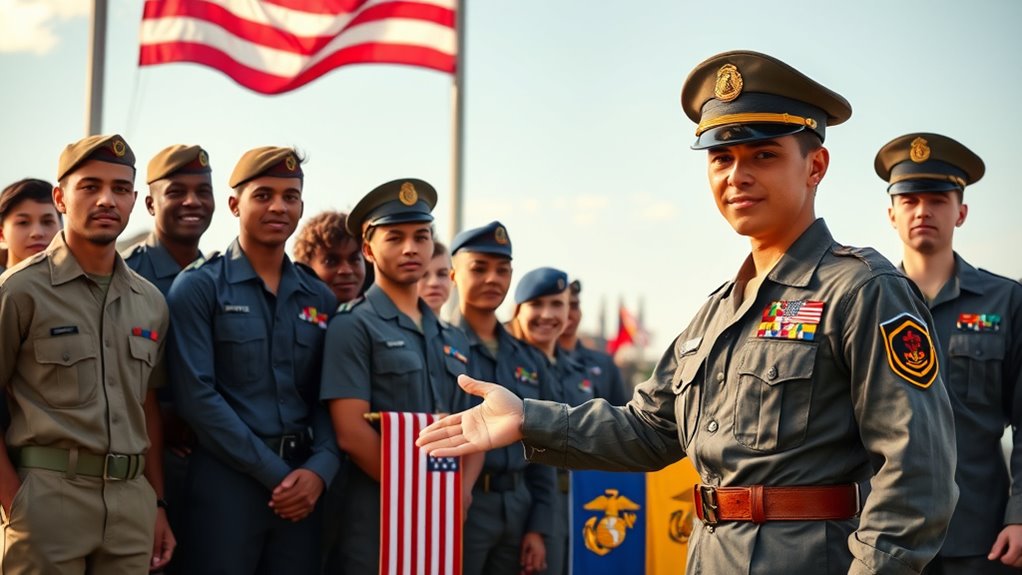If you’re considering military service, you’ve got a variety of options tailored to your skills and interests. You can choose from branches like the Army, Navy, Air Force, Marines, or Coast Guard, each with unique roles. You might serve actively full-time or in a part-time reserve capacity. Eligibility requirements include age, citizenship, and education. Whether you want a leadership role or hands-on work, each pathway offers opportunities for growth and development. There’s more to explore about these options.
Key Takeaways
- Various military branches like the Army, Navy, Air Force, Marines, and Coast Guard cater to different skills and operational focuses.
- Active Duty offers full-time service, while Reserve and Guard Forces provide part-time options for those balancing civilian careers.
- Compulsory military service exists in some countries, while others rely on volunteer forces that offer benefits like educational assistance and healthcare.
- Enlisted personnel make up the majority of the military, requiring a high school diploma, while officers need a bachelor’s degree or higher.
- Recruitment includes age limits and citizenship requirements, with background checks to assess moral character and disqualify individuals with serious offenses.
Types of Military Service

When considering military service options, you’ll find various branches and components tailored to different skills and interests. The Air Force specializes in aerial operations, while the Army focuses on land-based military missions.
If maritime security intrigues you, the Coast Guard or Navy might be ideal, with the Marines handling amphibious operations. Each branch of service has distinct roles and responsibilities that contribute to the overall mission of national armed forces.
In addition to branches, you’ll encounter different service components. Active Duty offers full-time commitment, whereas Reserve Forces provide part-time opportunities with regular training.
Guard Forces serve in dual state and federal roles, while Special Forces tackle specialized missions.
No matter your background, there’s a path in military service that aligns with your objectives and passions. Explore your options, and find the right fit for you.
Global Military Service Systems

How do countries around the world structure their military service? Military service systems vary widely. Some nations, like Israel and Norway, implement compulsory military service for both genders, while others have gender-specific requirements. The duration of service can range from 18 months to several years. Exemptions are often available for health issues or educational commitments in countries like Switzerland and Germany. On the other hand, volunteer military forces, seen in countries like the U.S. and Canada, attract individuals through benefits like educational assistance and healthcare. These volunteer systems reflect societal diversity but may struggle with retention amid civilian job competition. Many countries also utilize advanced military computer systems to enhance operational efficiency and decision-making processes within their forces.
Military Branches and Their Roles

Countries may structure their military service differently, but the roles of military branches within these systems are essential for national defense and security.
The United States Army conducts land operations and logistical support, focusing on peacekeeping and disaster relief. The Navy guarantees maritime freedom, safeguarding trade routes and preventing piracy. The Air Force maintains air superiority and supports ground forces through aerial operations. The Army guards U.S. installations and properties worldwide, ensuring a strong defense presence globally.
The Marine Corps specializes in rapid-response combat and amphibious warfare, often being the first on the scene. Meanwhile, the Coast Guard manages maritime law enforcement and environmental protection.
Each branch collaborates closely to achieve unified military objectives, adapting to diverse operational domains and missions to protect the nation effectively.
Enlisted and Officer Pathways

Understanding the paths to military service can help you make informed decisions about your career. You can choose between the enlisted and officer pathways.
Enlisted personnel, who make up about 82% of the military, typically need a high school diploma or GED and undergo Basic Combat Training followed by Advanced Individual Training. They focus on executing missions and technical tasks. Enlisted service members perform critical responsibilities in various fields such as construction, transportation, and healthcare.
On the other hand, officer positions require a bachelor’s degree or higher and involve leadership and strategic planning. Officers manage enlisted troops and make up around 18% of personnel.
Both pathways offer advancement opportunities, but they cater to different skill sets and responsibilities, so consider what aligns best with your career goals.
Recruitment and Eligibility Requirements

When considering a military career, it’s essential to be aware of the recruitment and eligibility requirements that vary across branches.
You must typically be at least 17 with parental consent or 18 without. Age limits differ: the Army, Navy, and Air Force accept applicants up to 42, while the Marine Corps caps at 28.
U.S. citizenship is required, or a valid Green Card for non-citizens. A high school diploma or GED is important, and physical and medical standards must be met, including passing a thorough examination.
Background checks assess moral character, and felonies, especially violent crimes, usually disqualify candidates. Waivers may be available based on service needs, but maintaining a clean record is crucial.
Frequently Asked Questions
What Benefits Come With Military Service After Completing Active Duty?
After completing active duty, you gain access to a variety of benefits.
You’ll be eligible for a pension, ensuring financial stability in retirement. Your Thrift Savings Plan helps grow your savings, while favorable home loan terms make buying a house easier.
Education benefits like the GI Bill cover college costs, and VA health care provides extensive medical services.
Plus, career support through change programs helps you successfully enter civilian life.
How Does Military Service Affect Civilian Job Opportunities?
Military service can catapult you into a world of civilian job opportunities like nothing else! Your training equips you with invaluable skills like leadership, adaptability, and problem-solving that employers crave.
You’ve got technical expertise from hands-on experience, making you a hot commodity in sectors like engineering and cybersecurity.
While shifting might present challenges, resources are available to help you articulate your strengths and secure a fulfilling career that aligns with your skills.
Can Military Service Be Combined With College Education?
Yes, you can definitely combine military service with college education. Many service members take advantage of programs like ROTC or the GI Bill, which provide financial support for tuition.
Balancing your military duties with coursework can be challenging, but flexible class options and military-friendly institutions help.
The skills and experiences you gain from both arenas enhance your career prospects, making you a more competitive candidate in both military and civilian job markets.
What Support Is Available for Veterans Transitioning to Civilian Life?
So, you’ve bravely donned the uniform, and now you’re expected to waltz back into civilian life like it’s a stroll in the park? Well, good luck!
Fortunately, you’ve got the VA’s extensive benefits, TAP’s resources, and nonprofit organizations ready to catch you if you trip. From mental health support to job training, there’s a safety net.
Just remember, moving from military to civilian life isn’t a one-size-fits-all—embrace the help, and you’ll find your footing!
Are There Options for Serving Without Combat Involvement?
Yes, you have several options for serving without direct combat involvement.
About 80% of military jobs are non-combat roles, including positions like healthcare professionals, engineers, and administrative staff. These roles are essential for supporting operations and provide a safer environment.
Plus, you’ll gain valuable skills that ease your adjustment to civilian life. With competitive salaries and benefits, non-combat positions can be a fulfilling alternative if combat isn’t for you.
Conclusion
In summary, understanding your options in military service is like steering through a vast ocean; each branch is a different current that can lead you to unique opportunities. Just as a sailor must choose their course wisely, you should consider your goals and values before enlisting. Remember, in 2022, over 150,000 individuals found fulfilling careers in the military. So, take the time to explore your choices, and you’ll discover a path that resonates with your ambitions.









